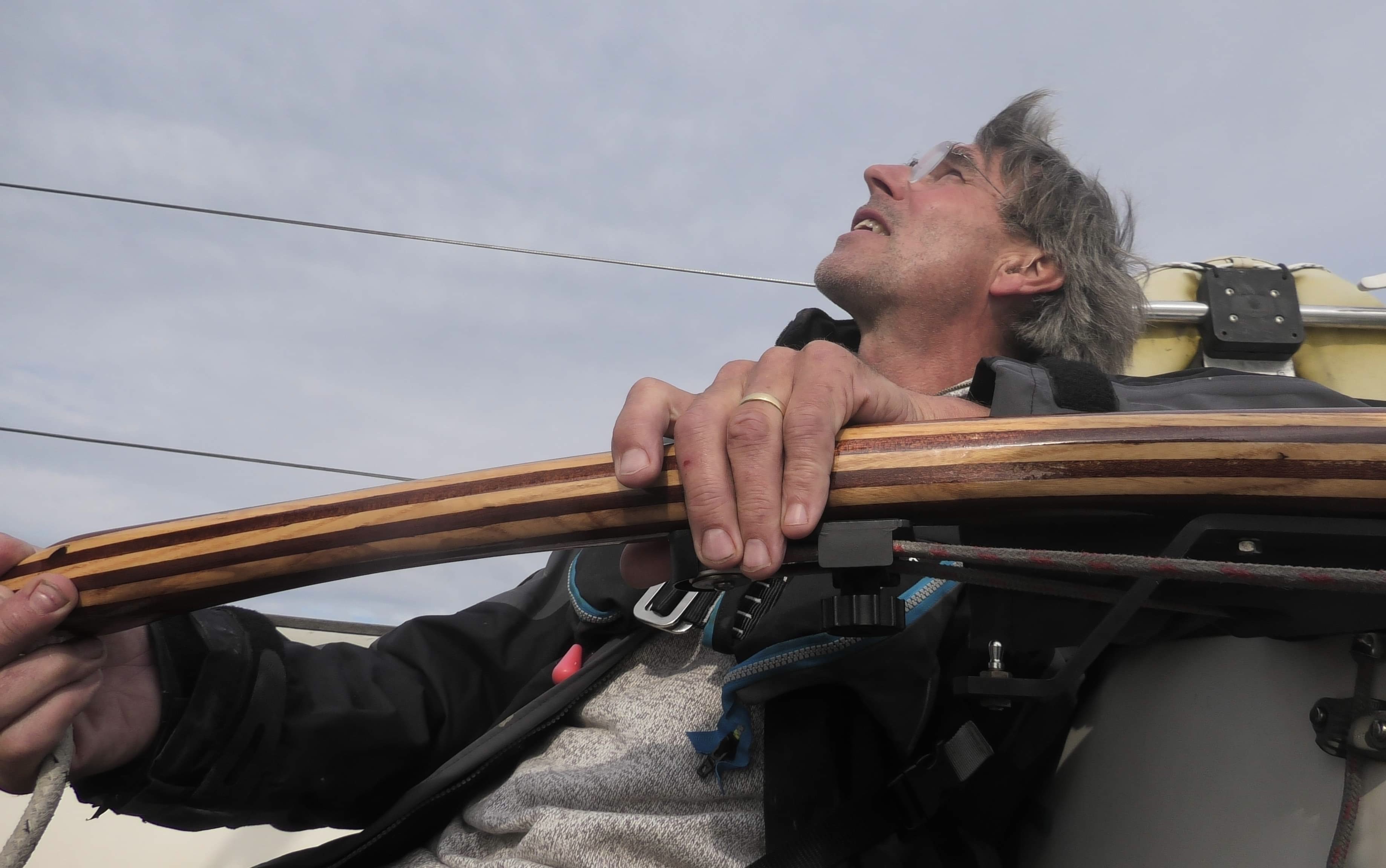Summer Sailing 2022
The following is a combined account of several outings in the Thames Estuary on Snow Goose over the summer of 2022.
I wonder to what extent my sailing suits my boat and to what extent the boat suits my sailing. Snow Goose is what it is; a lovely, simple cruiser designed in the 1960s for 'family sailing'. That is, not too fast or scary but stable, roomy and comfortable. There are of course times when it doesn't feel like that, in rough seas, a nasty Thames Estuary chop or a stiff wind on the nose, but mostly the boat works well for me. Often sailing single handed I err on the cautious side in my passage planning and aim to work with the tides not against them. Sailing, to those in the habit, is not boring. It is different every time you go out, always a visual delight, always a learning experience and there is an 'old man and the sea' quality to the reflective feeling of passing time over the course of a long day's passage. This summer it has also been hot, sometimes too hot. There is no escape if you are out there for ten or twelve hours in the sun. So we are browner this year and occasionally we have 'cooked', adding to tiredness and contributing to seasickness for the unlucky. But the fine weather has been mostly a pleasure bringing with it more than the normal share of high pressure and light north easterly winds.
May and June
I took several day sails and short cruises in the early summer down the Medway anchoring for a night or two as far as possible down Stangate Creek where it is quietest and the wildlife and tides most interesting. At the southern end Stangate Creek branches to the west into Halstow Creek and to the east into The Shade. Both are rewarding anchorages but the strangely named Shade is preferable if other boats haven’t got there first. Here the birds pick their way along the tideline quite close to the boat and occasionally there is a seal nosing along in the rising tide.
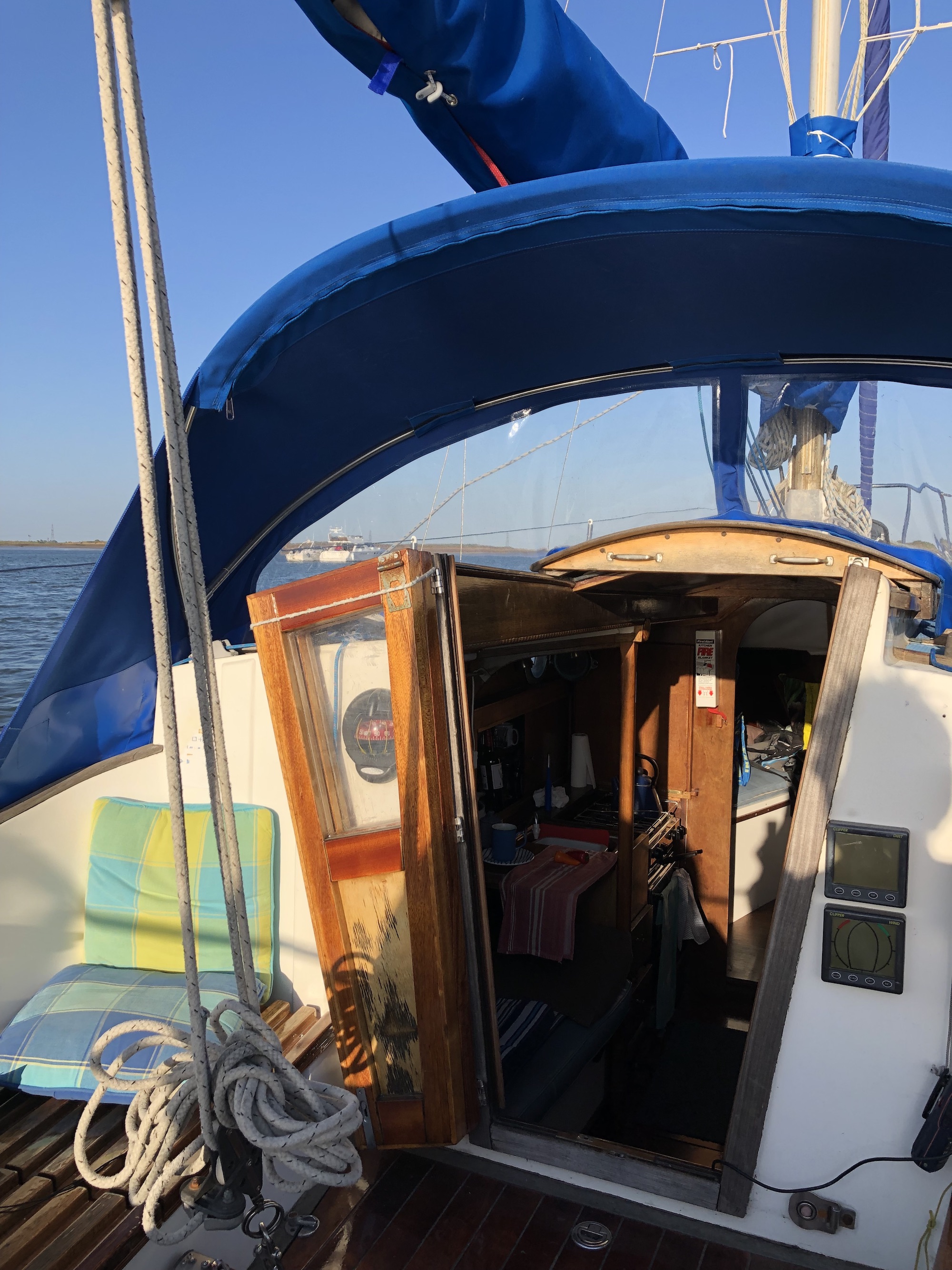
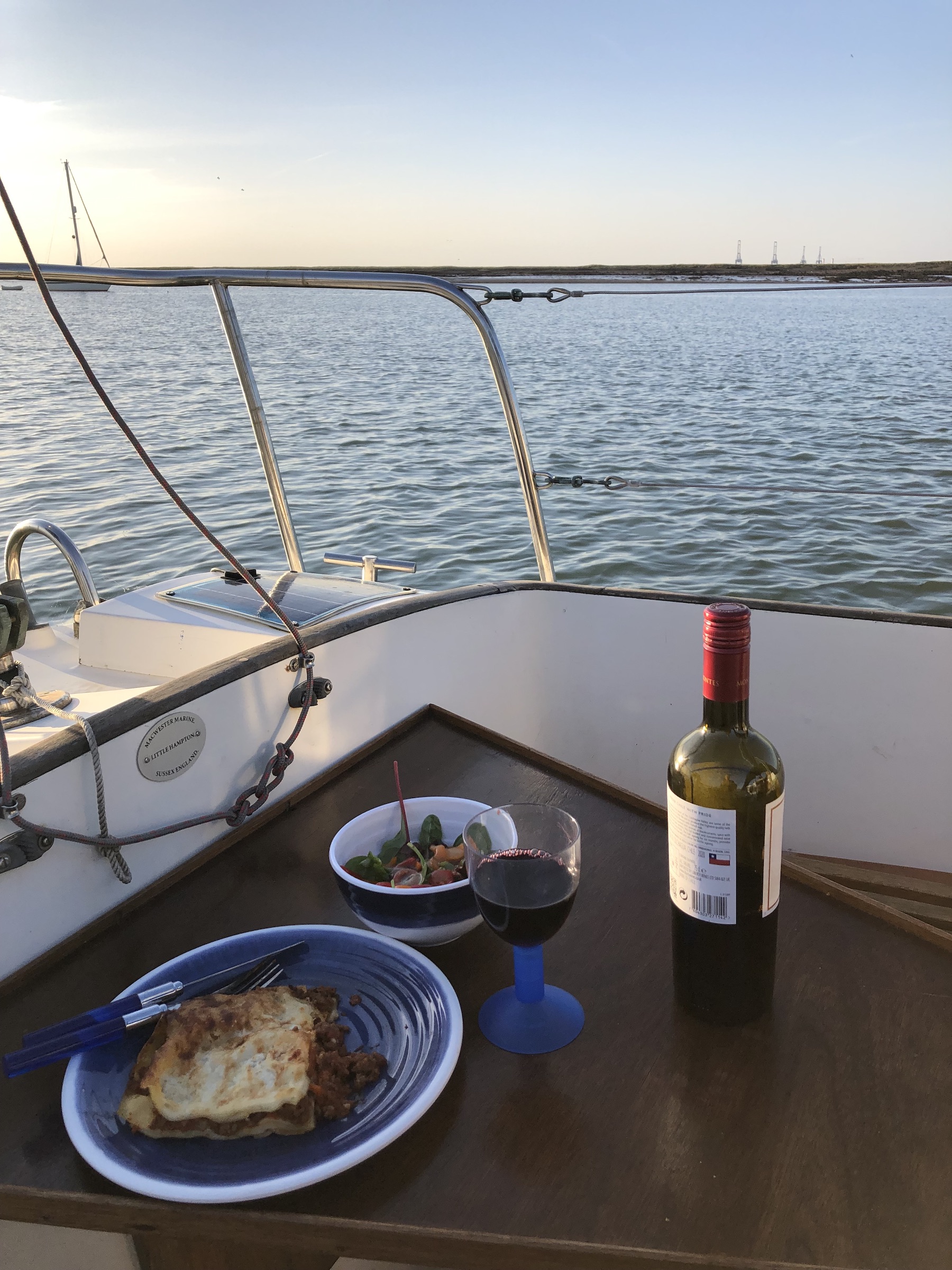
July - Greenwich Yacht Club East Coast Cruise 2022
No longer organising the East Coast Cruise has the benefit of allowing me to join in without the stress of leadership or the responsibility of getting the planning right. This year I went with my old (as in previous) crew Ian, good company and a good team.
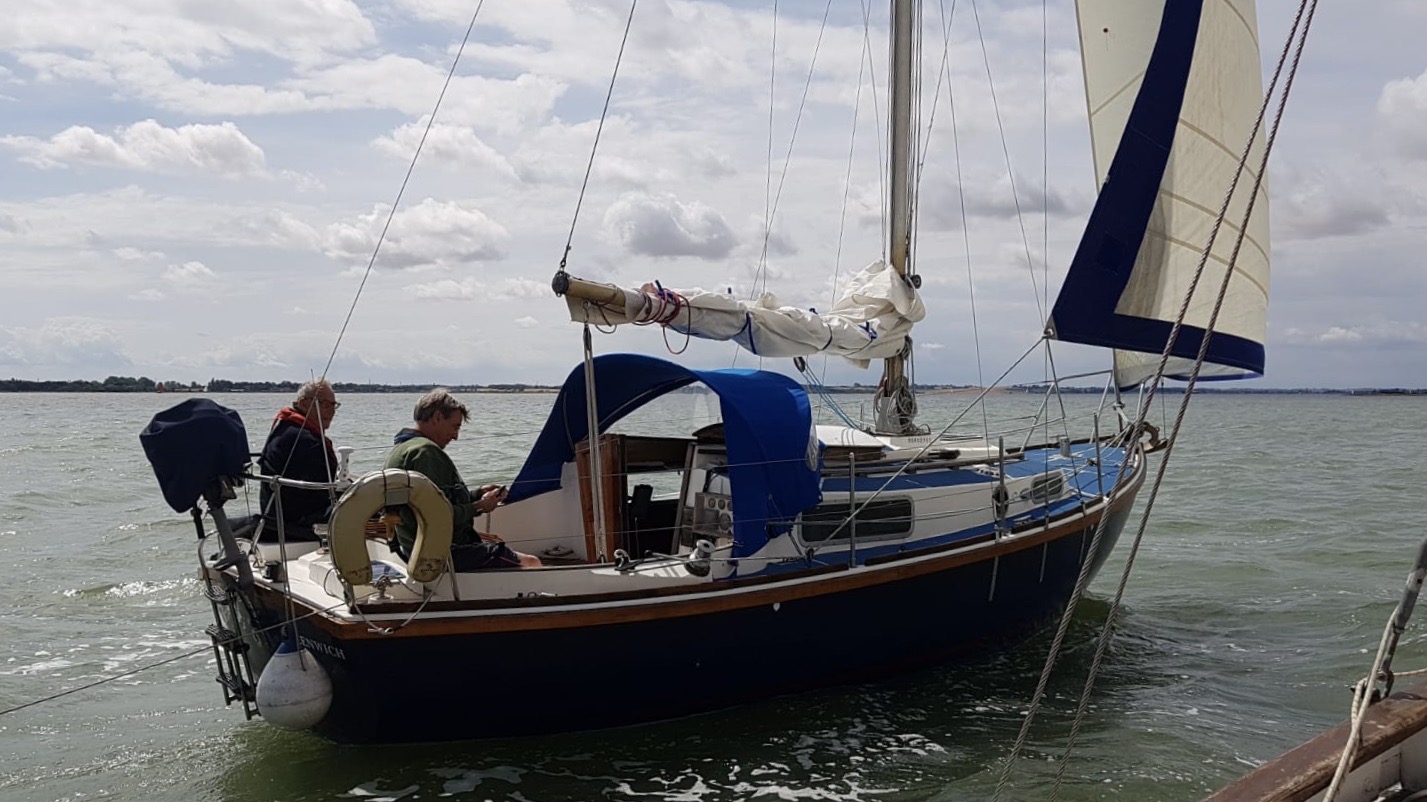
Day 1 - Gillingham to Queenborough
Wind SW 5-10 knots
Happily sailing the same route many times over is not a chore, more a ritual - different each time thanks to the weather and tide but reliably the same in its landmarks and destinations. My crew Ian and I set out for the run down to Queenborough in the company of two other boats Orinoco and Rochelle who, as it happens, we did not see again after leaving the lock at Gillingham until arriving at Queenborough. With 2 1/2 hours of outgoing tide left we had just enough left for a gentle sail all the way down. Eos from GYC was already there on the grey visitors’ buoys. We joined them and within a couple of hours there were nine GYC boats rafted up on the buoys.
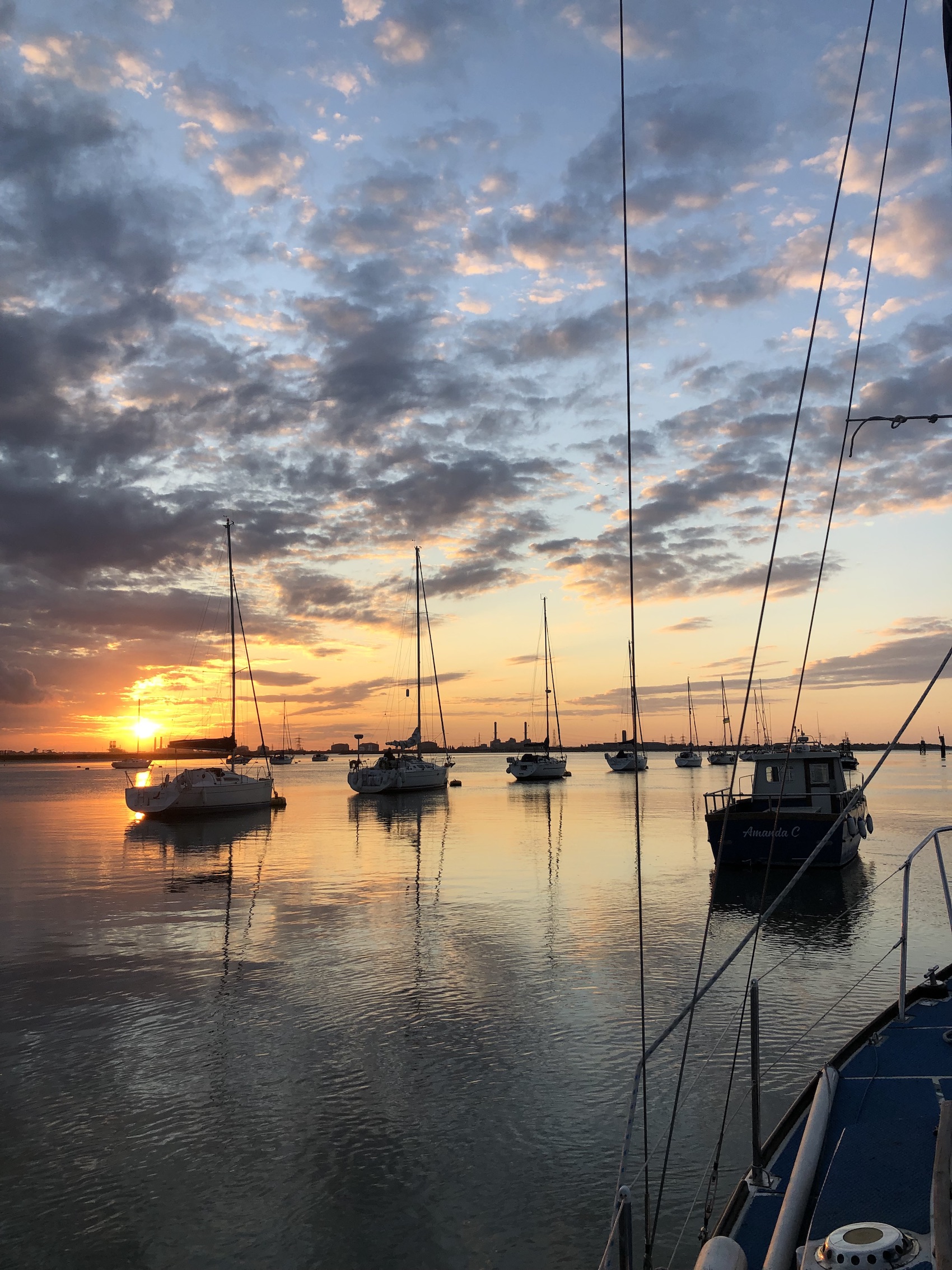
Day 2 - Gillingham to Queenborough
Wind SW 5-10 knots
We set out at 0930 and with the freshening wind behind us sailed goosewing pretty much all the way to the Spitway. The wind always seems light on a run but this is deceptive and from the Spitway on, as we came on to the wind the passage turned into a brisk beat to Brightlingsea. It felt good to do this leg at pace for a change, surfing off waves and reaching 6 knots easily. The wind had built beautifully through the day - good for confidence. Although this was a quick crossing it felt like a long day in the considerable heat – hats were essential.
It is difficult to maintain an optimal course goosewinging without poling out or rigging a preventer on the main – I find I need the wind to be just on the quarter to pin the Genoa flat. It works when you get it right, the narrow channels that make up the Thames Estuary permitting of course.
This was a day of lovely light, the pale green sea turning darker towards the end of the day. We had one seal for company.
We rafted up in Brightlingsea between contrasting boats, Amity a ferro cement gaffer and Shuda a GRP Bowman Folk boat derivative. The variety of boats that make up the GYC fleet is a particularly good aspect of these cruises.
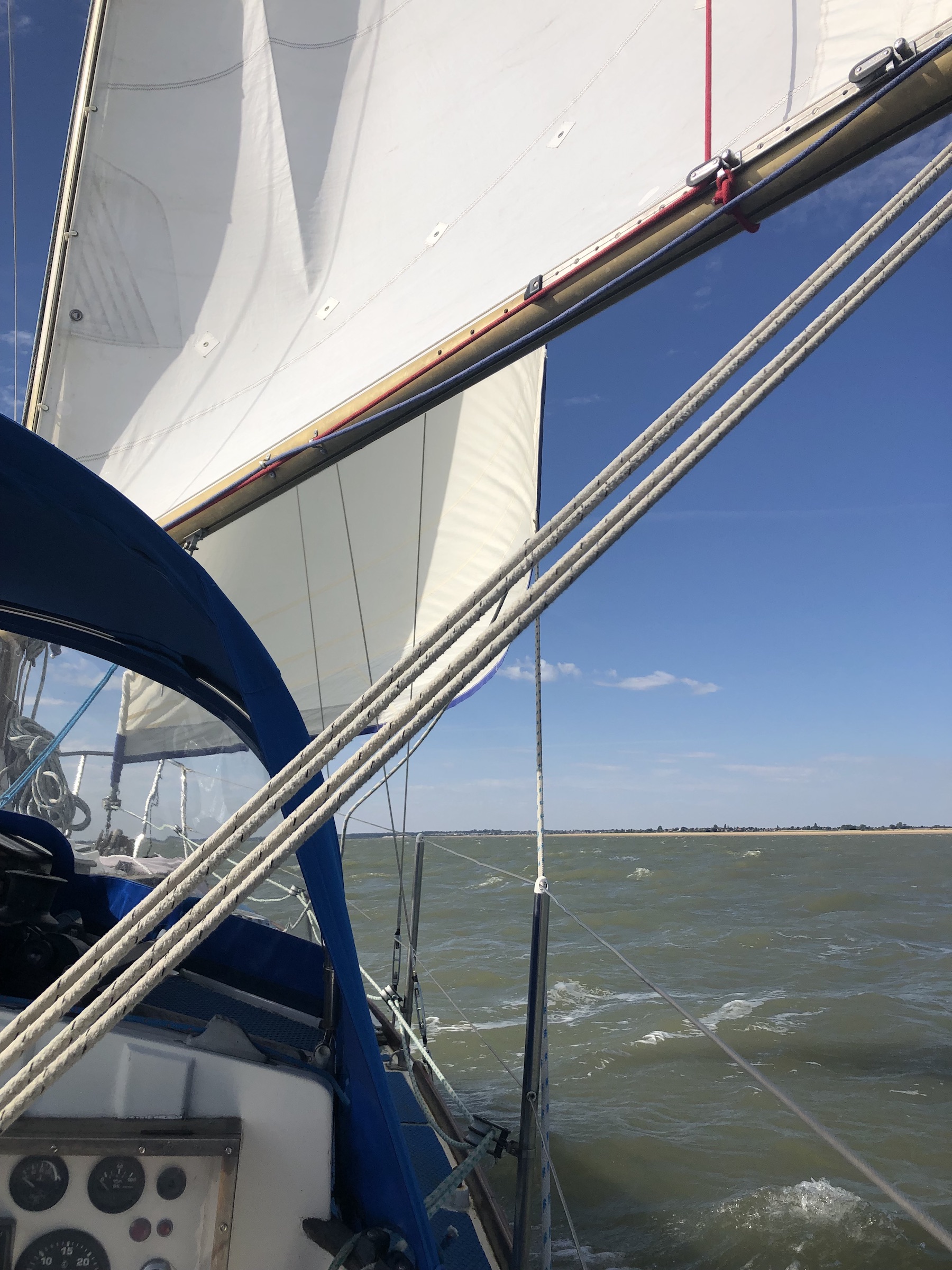
Day 3
The wind continued to build overnight and by morning its was enough to make the beat up the Blackwater in a 20 knot plus westerly unattractive. So this became a rest day and a we had a more than usually interesting explore in Brightlingsea, the older High Street giving clues to the town’s maritime history and a generally refreshingly unpretentious air.
Day 4 - Brightlingsea to Bradwell
Light winds led to a certain amount of unwelcome motoring but a pleasant enough run up to Bradwell. We stayed as close to the Mersey shore as depth would allow, crossing the Cocum Hills (great name) and picking up the rising tide into the Blackwater. We came in under watchful eye of the now silent twin towers that are the defunct Bradwell nuclear power station. Bradwell Marina was nonchalantly welcoming and the boats dispersed around the marina. The afternoon led us on a special, if long walk, along the roman road to the Saxon church of St Peters on the Wall. This is a wonderful spot, the church was built by st Cedd in the 7th century out of the stones and brick of the ruined Roman fort of Othona. Our visit was made more special by a population of tiny angels (swallows) flying about the roof beams - a moving experience.
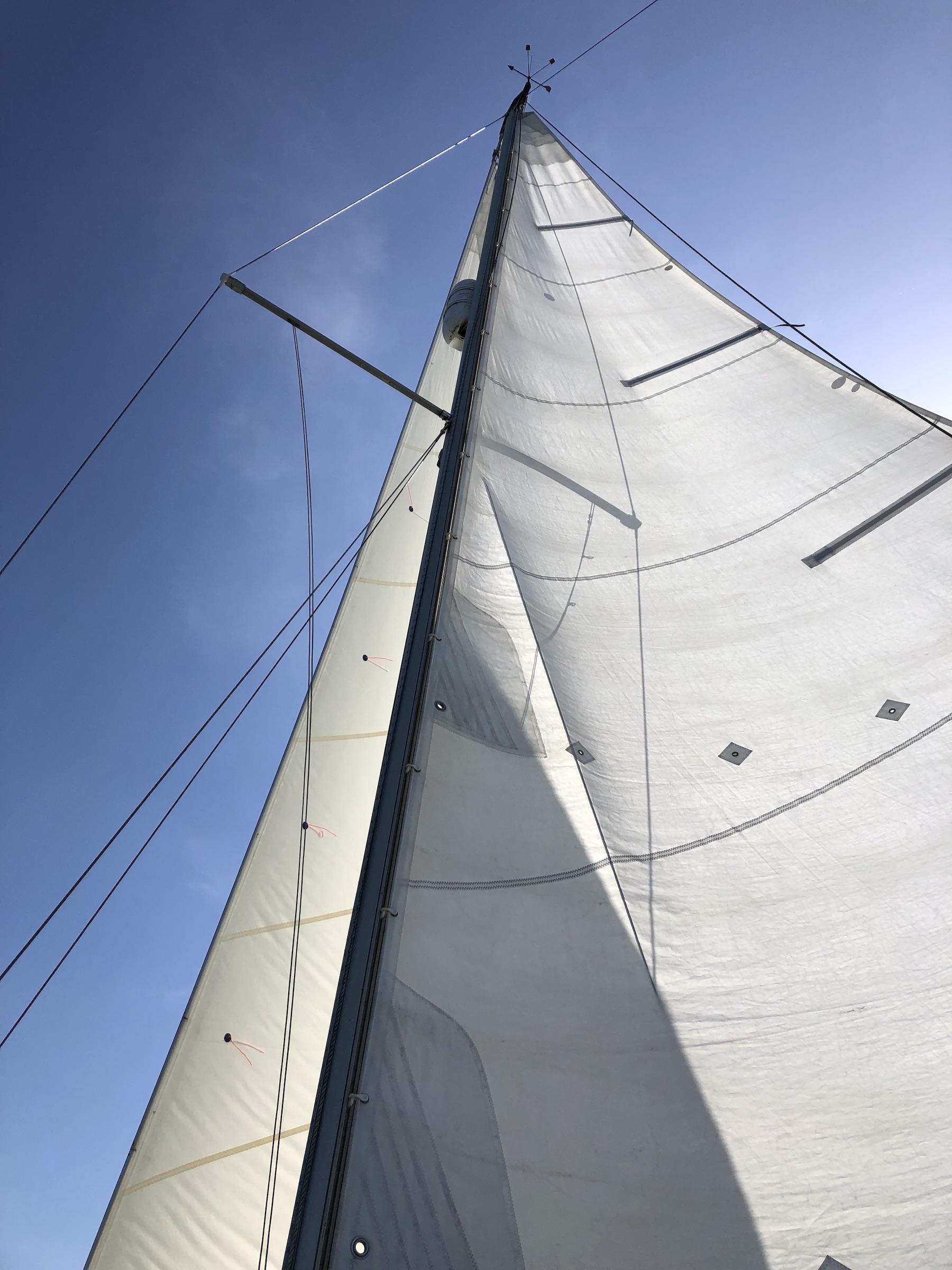
Day 5 - Bradwell to Tollesbury
A short hop on a fine windy morning. The fleet sailing in close company for a change with the boats converging slightly inconveniently on the large West Mersey Optimist fleet before processing up the creek into Tollesbury. This close procession resulted in some berthing chaos in the tight space of the marina, with too many boats trying to get into their berths at once. But we got there in the end and Tollesbury Marina is a really nice spot - Essex at its eccentric best, public tidal bathing pool, sail lofts, saltings and hospitable sailing club.
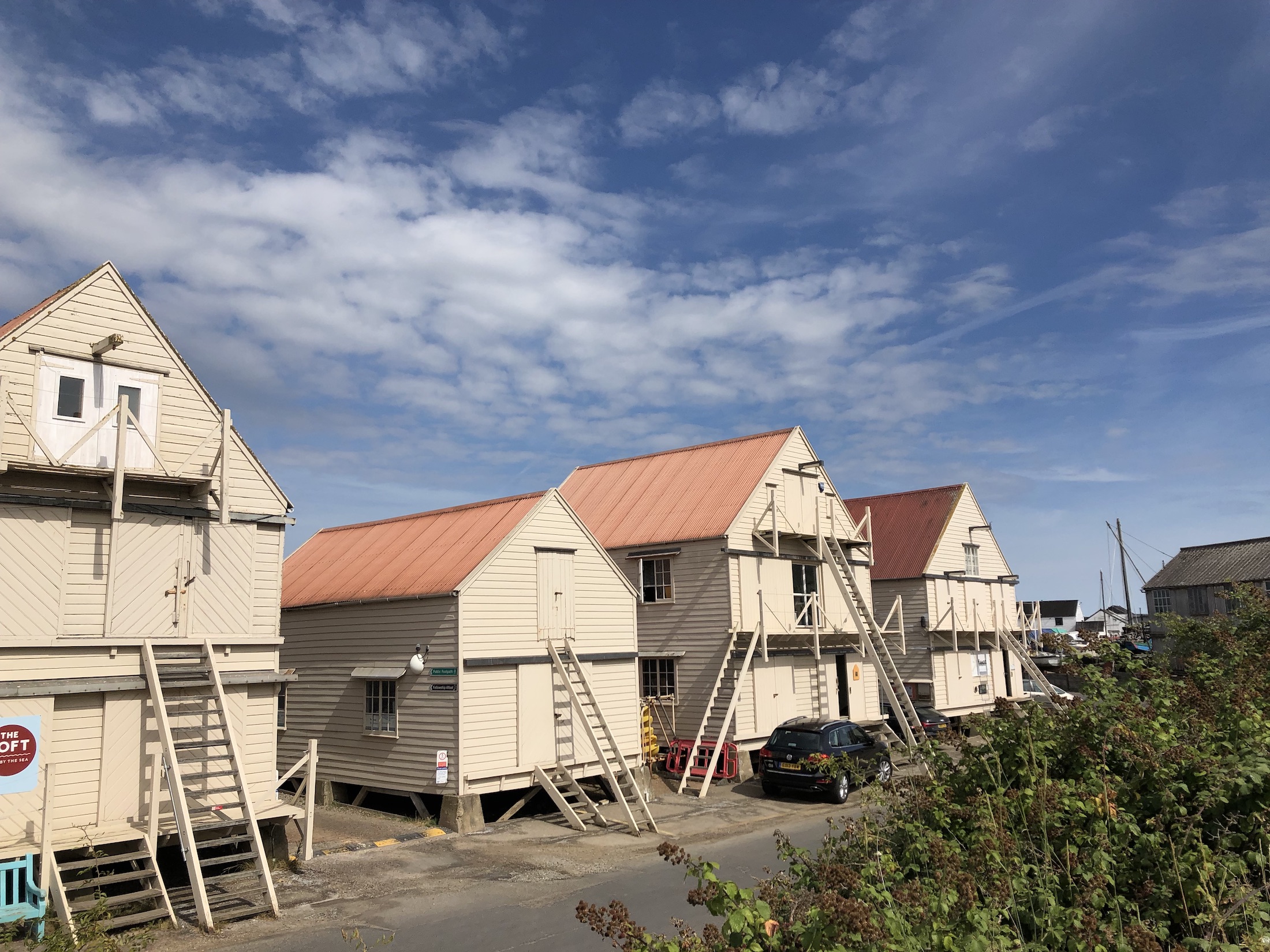
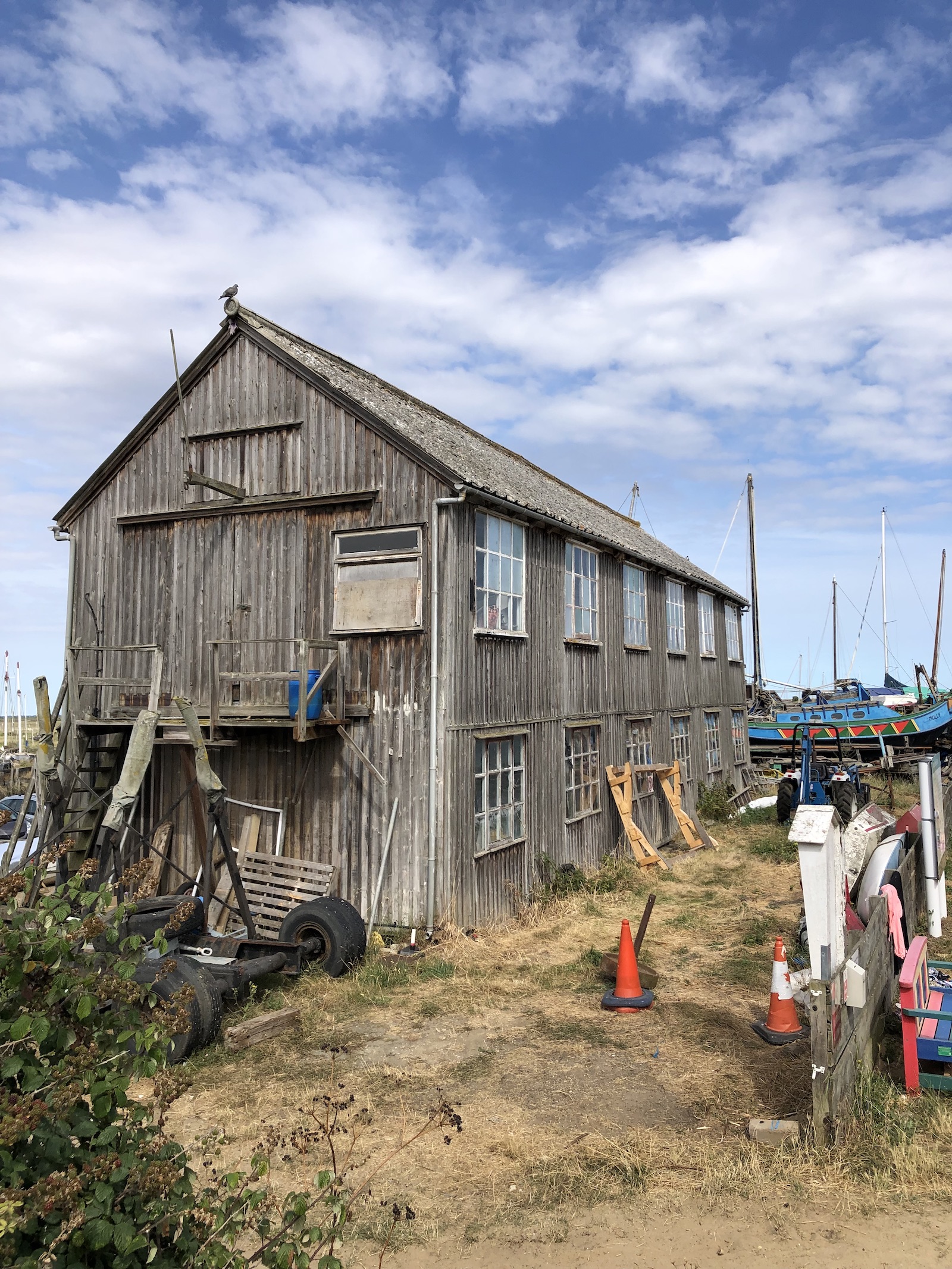
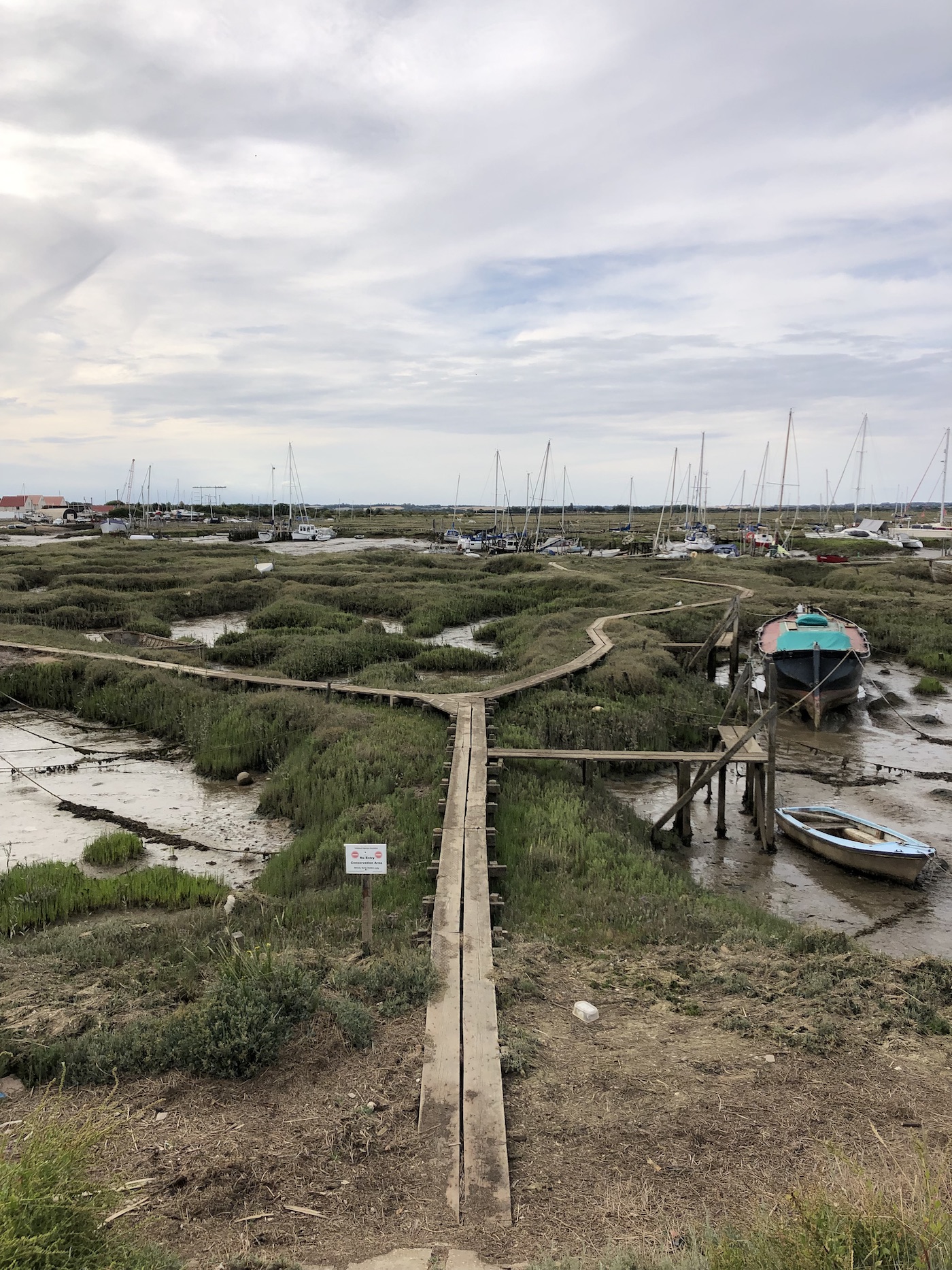
Day 6 - Tollesbury to Pyefleet
Wind Easterly 20-23 knots, on the nose of course.
A fine beat out of the Blackwater in a strong easterly made more eventful when Ian noticed one of the (thankfully) leeward shrouds hanging free. It had lost its Clevis Pin, presumably the split ring had worked itself out, and was doing nothing to hold up the mast. This was one of the two lower shrouds so may not have been critical to keeping the mast up but in those winds I wonder what would have happened if we were on the other tack with the remaining shrouds taking the full weight of the wind and sails. Although we were still in the estuary we still had enough sea room on that southward tack for me to go below, get out some spare bolts and lie on the deck jury rigging the shroud while Ian sailed us on. After lying on the deck struggling with the shroud and its fixing while the boat sailed on I finally fixed it and drew a sigh of relief and we went about and sailed on to Pyefleet. I had thought of going in to Brightlingsea for a replacement Clevis Pin but decided the nut and bolt jury fix was good enough for the rest of the cruise. So we anchored up and rested for the afternoon.
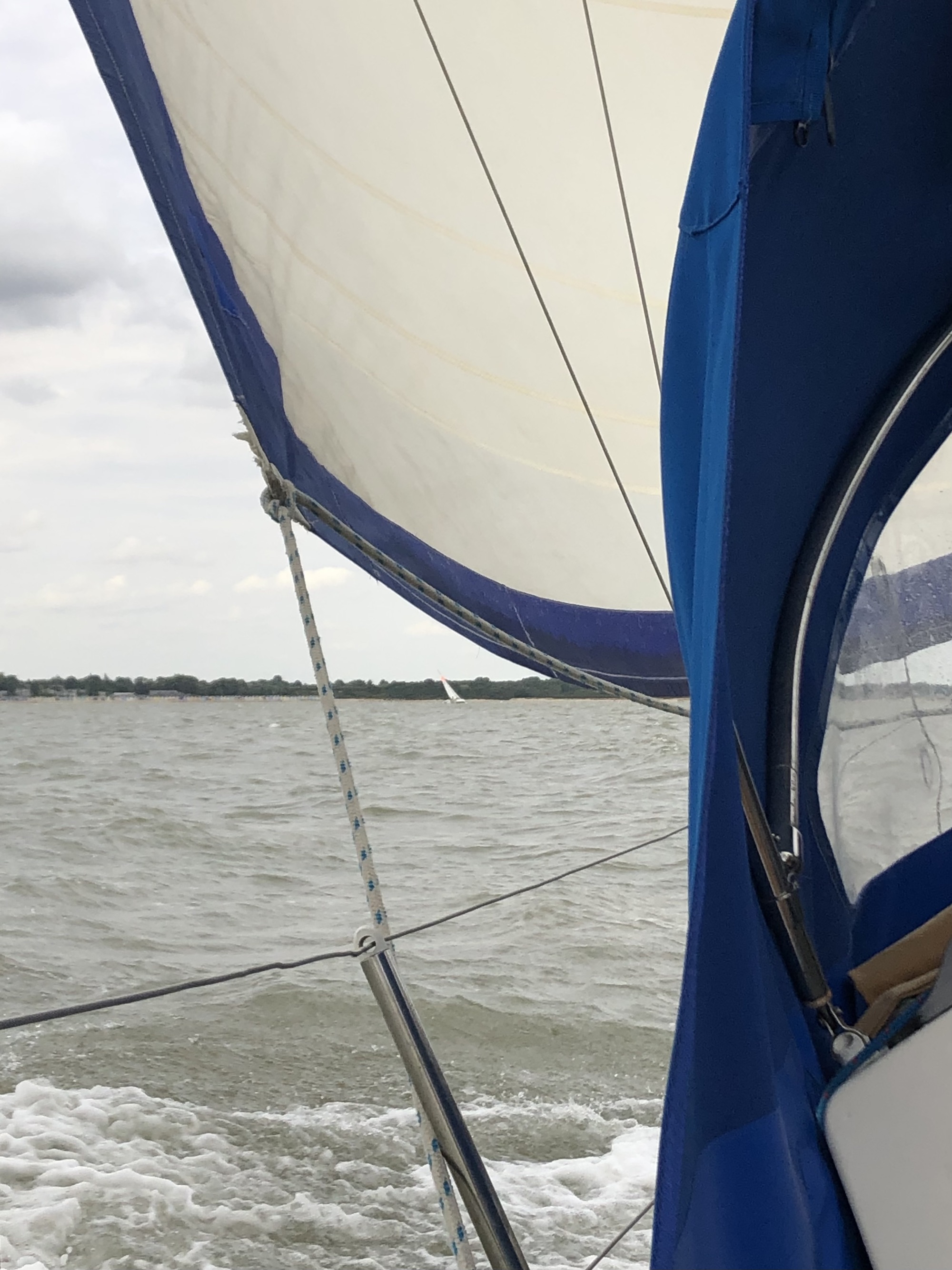
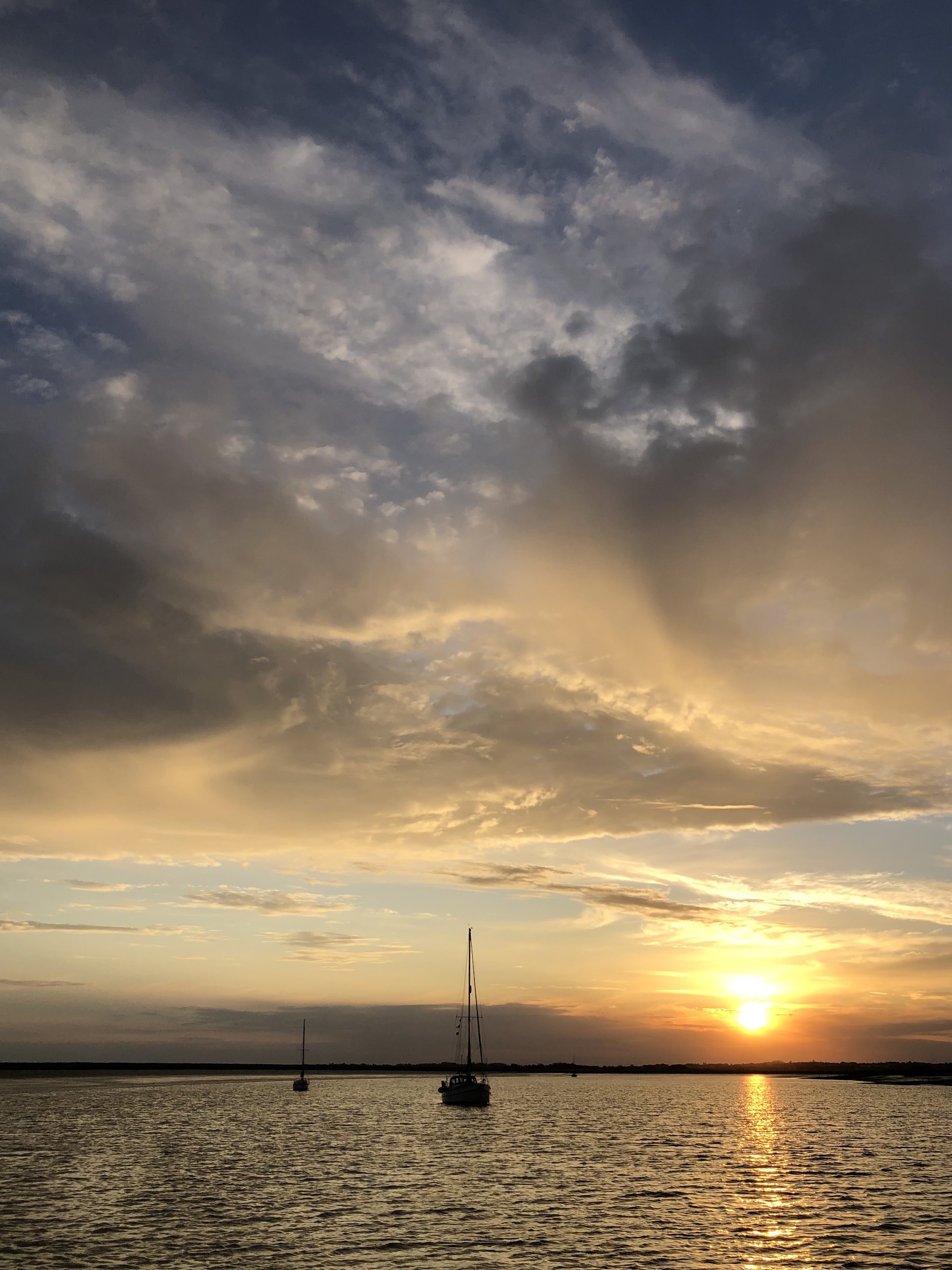
Day 7 - Pyefleet to Harty Ferry
Wind NE 5-10 knots
An early start at 0530 got us out into the sea in the growing morning light and out the the Spitway, through which gap all boats heading south must pass, in time for low water and to catch the rising tide all the way to Harty Ferry. I have been caught out before by leaving this too late and having a very long day of it as a result. This time other boats had left before us but I think we timed it right, taking just under two hours to get to the Spitway dead on low water. Although this means the water over the Spitway would be at its shallowest, we still had 1.9m under the keel (at Springs -2 days). So we turned South West and goosewinged all the way to the Swin before heading South for the Kentish Flats and eventually the Colombine Spit. We had the engine on as the wind died coming into the Swale and arrived at Harty Ferry spot on high water at the same time as Amity, the other GYC boat still with us. A good day's run but I could wish Snow Goose had the sail area for the lighter winds. To some extent I could help this with more use of my big cruising chute on the broad reaches and told myself I must make the effort and use it more often.
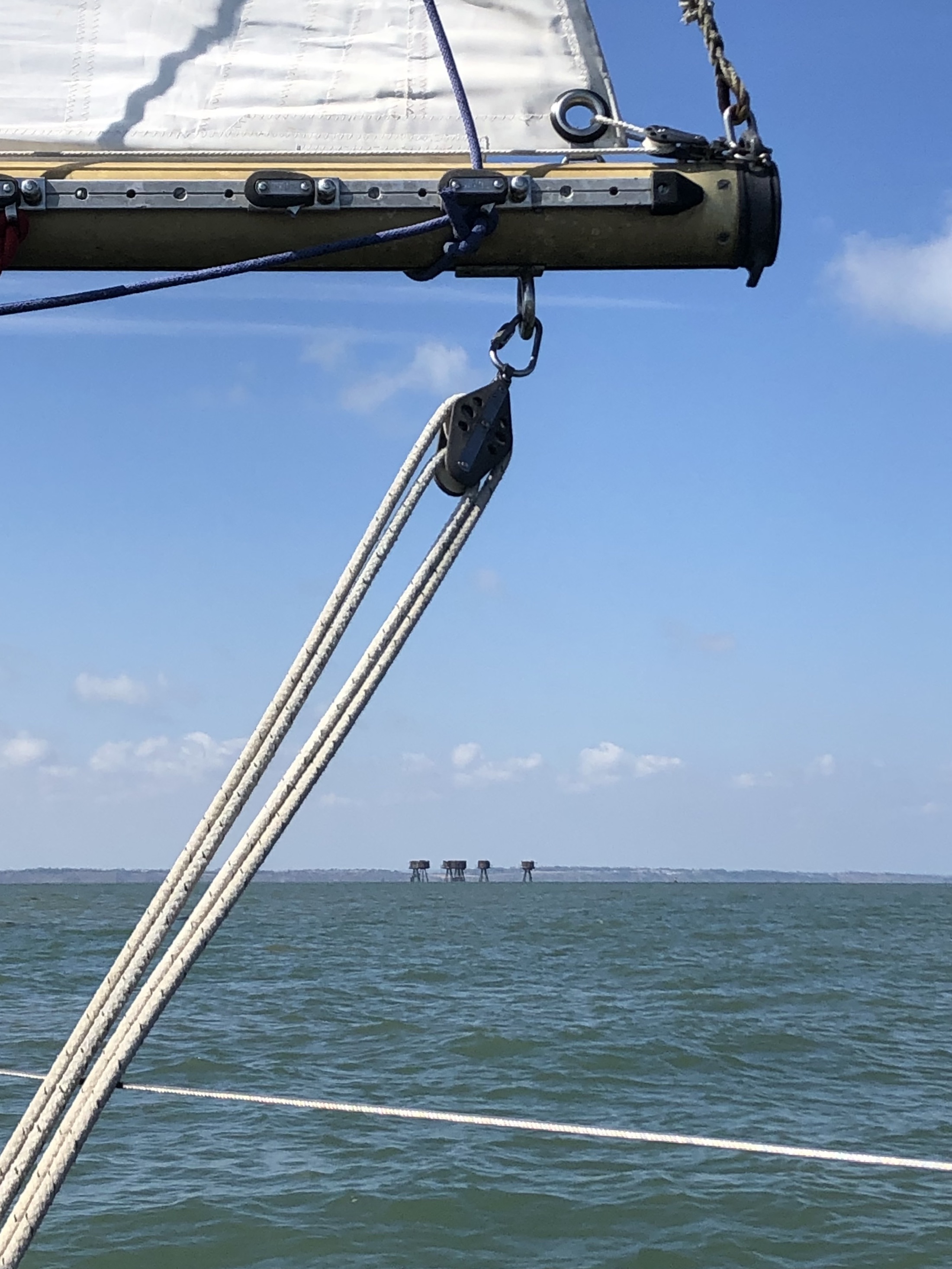
What started as an uneventful evening at anchor developed somewhat. The crew of Amity decided to go ashore to the pub for dinner. Seeing that they did not have an outboard I leant them ours and off they went. We saw them struggling a bit with their inflatable tender on the shore but thought little of it until later learning that they had punctured it's tube and were stuck on shore. The wind was still too high for me to row my tiny tender against the wind to pick them up so they explored all options for getting back to their boat with increasing desperation. Fortunately the wind eventually died enough for me to help. We moved Snow Goose as close in to the shore as depth would allow and I rowed over to the mud to pick up first Elliot and my by now very muddy outboard, then in relays, the other crew members. My tender is very small, too small! and can only take one passenger so it was slow and muddy work getting in as close as possible to the marooned crew each time. Somehow on the last trip in to pick up Jon the outboard sputtered to a stop (fuel starvation) and I decided to row. This is hard work two up in little more than a coracle but we got there in the end partly thanks to Elliots fine helming of Amity which he brought in very close to shorten the journey. Hard work all round and it made me even more cautious about going ashore in these very tidal waters.
Day 8 Harty Ferry to Queenborough
Wind West 5-10 knots
The wind seemed to flip east to west to the wrong direction several times on this cruise and we were unlucky with the wind again on this day. So we agreed with Amity to motor together through the Swale and under The Kings Ferry Bridge to Queenborough. Both boats struggled to raise their anchors bringing up huge quantities of weed. There was too much to raise by hand I had to carefully pull it off the chain and the anchor while it was still in the water bit by bit. Hard work! I wonder if this much weed was the result of such a long hot summer, I had certainly not encountered it before at Harty Ferry.
An enjoyable and uneventful trip through the Swale to Queenborough following a surprisingly large ship through the Kings Ferry Bridge. We were treated to a good meal ashore that evening by the Amity crew.
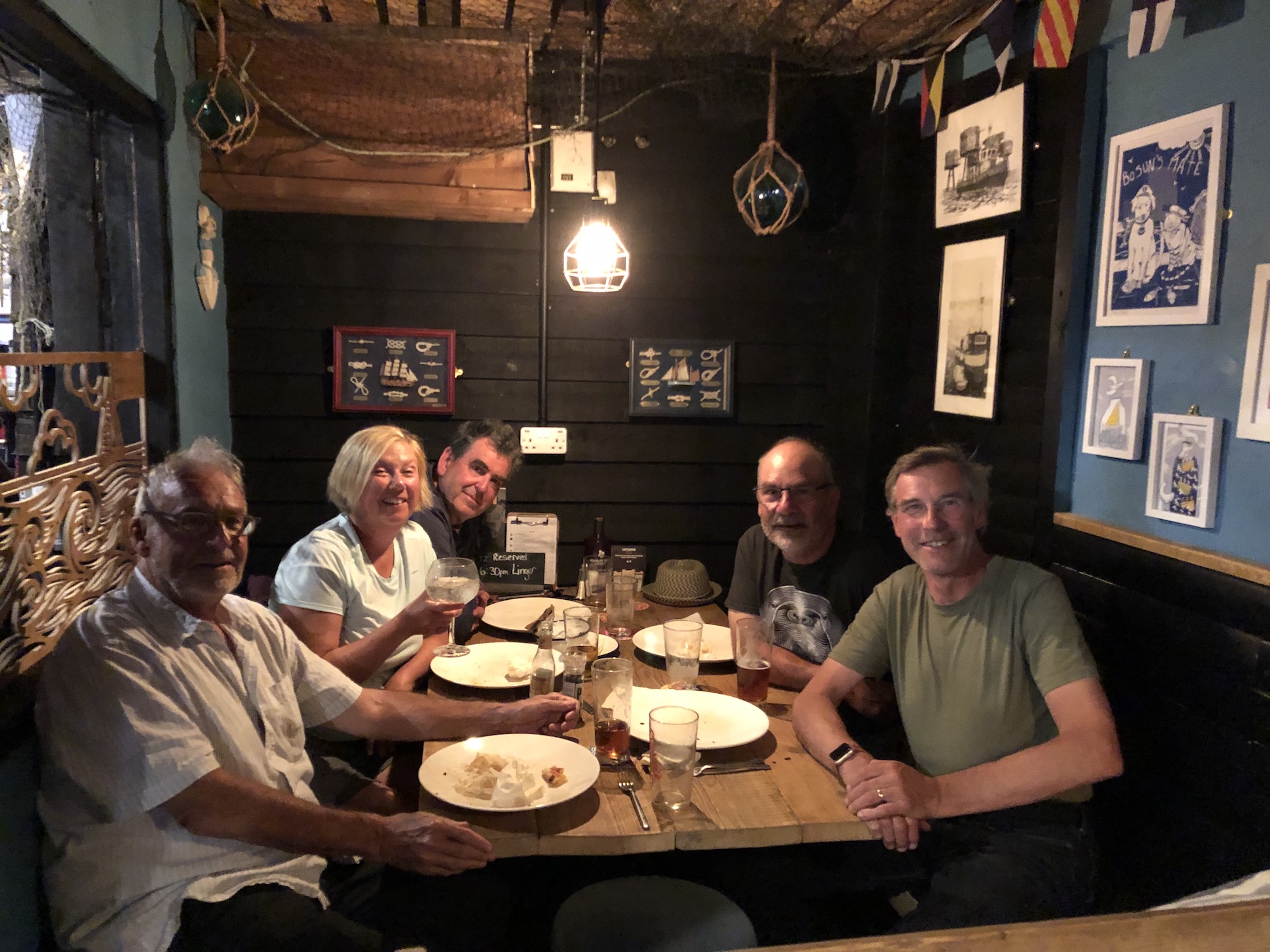
Day 9 - Queenborough to Gillingham
Wind West 20+ knots
Another wind on the nose day so a motor sail up the Medway to Gillingham using the sail to give us as much as a knot more speed by doing a series of close hauled tacks.
Apart from the occasional seal we did not see much wildlife this week so we hoped to see the temporary resident seal in Gillingham Marina on our return but it had sensibly made a bid for freedom a day or so before.
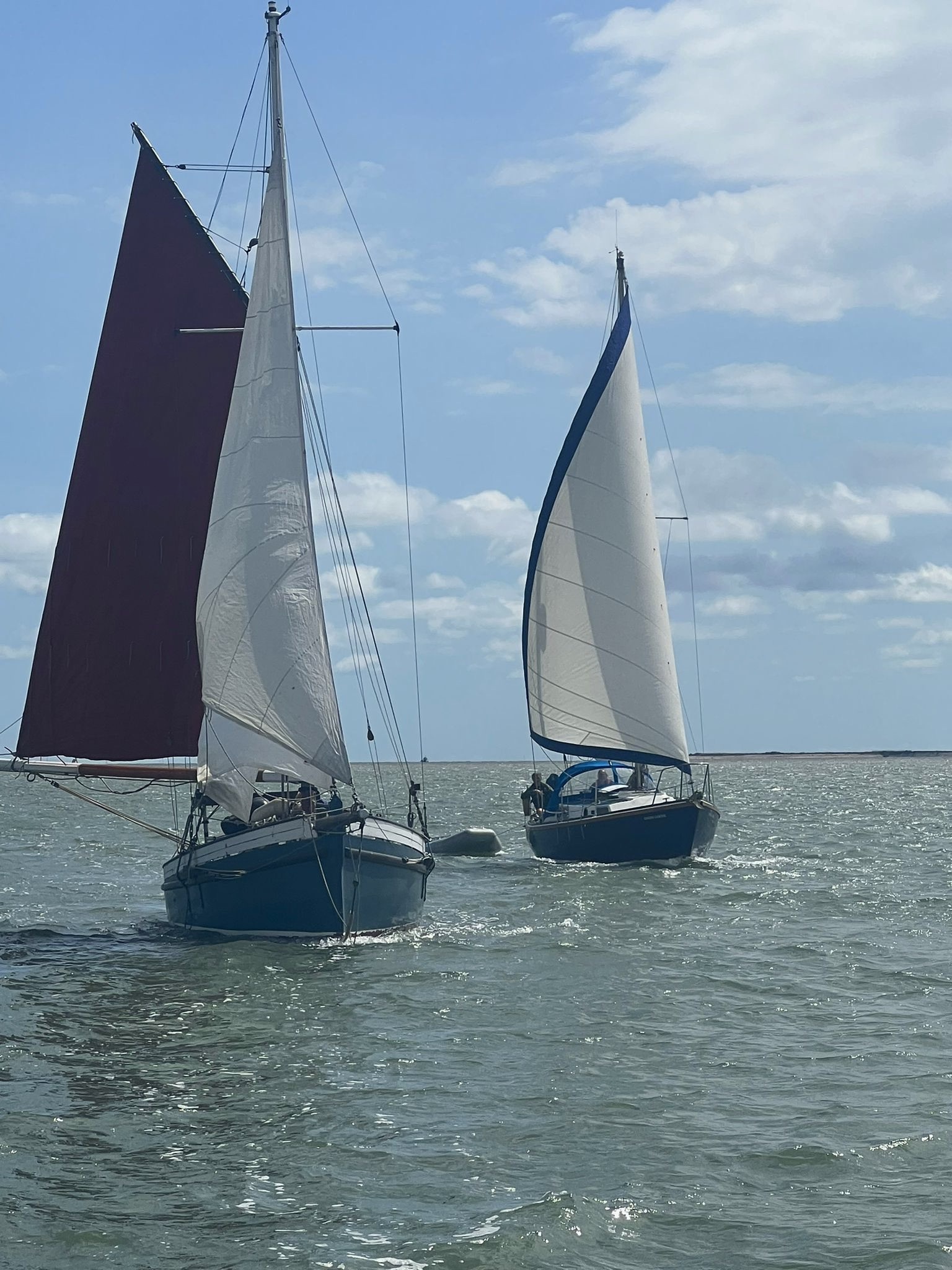
August
Havengore - the Other Route to Burnham on Crouch
I had done the Havengore route across the Maplin Sands and through to the upper reaches of Roach from the Thames Estuary once before, many years ago in my Drascombe Coaster Spray. That was an epic day’s run all the way from GYC to Burnham on Crouch in one go. The Drascombe having a very small draft did not struggle with the shallow waters across the sands but it was an adventure nonetheless with lessons in tides, navigation and learning to spot buoys and markers at the edge of visibility. This time on Snow Goose, a Macwester 27 with a draft of 1.2m, was a little different. I am older now and more cautious and I aim to plan routes to work with the tides not against them. Of course this is not always possible and taking the Havengore route to the Roach and Crouch from the Medway means working against the tide for at least some of the time. But when my friend Pablo Behrens who is making film documentaries about the Thames Estuary told me he needed footage of sailing into the Roach from the Havengore I did not need to think about it for long before saying yes. He also needed to film the resting place of the Beagle, of Darwin and Fitzroy fame, in the mud of the Roach. So this and the Havengore became our assignment.
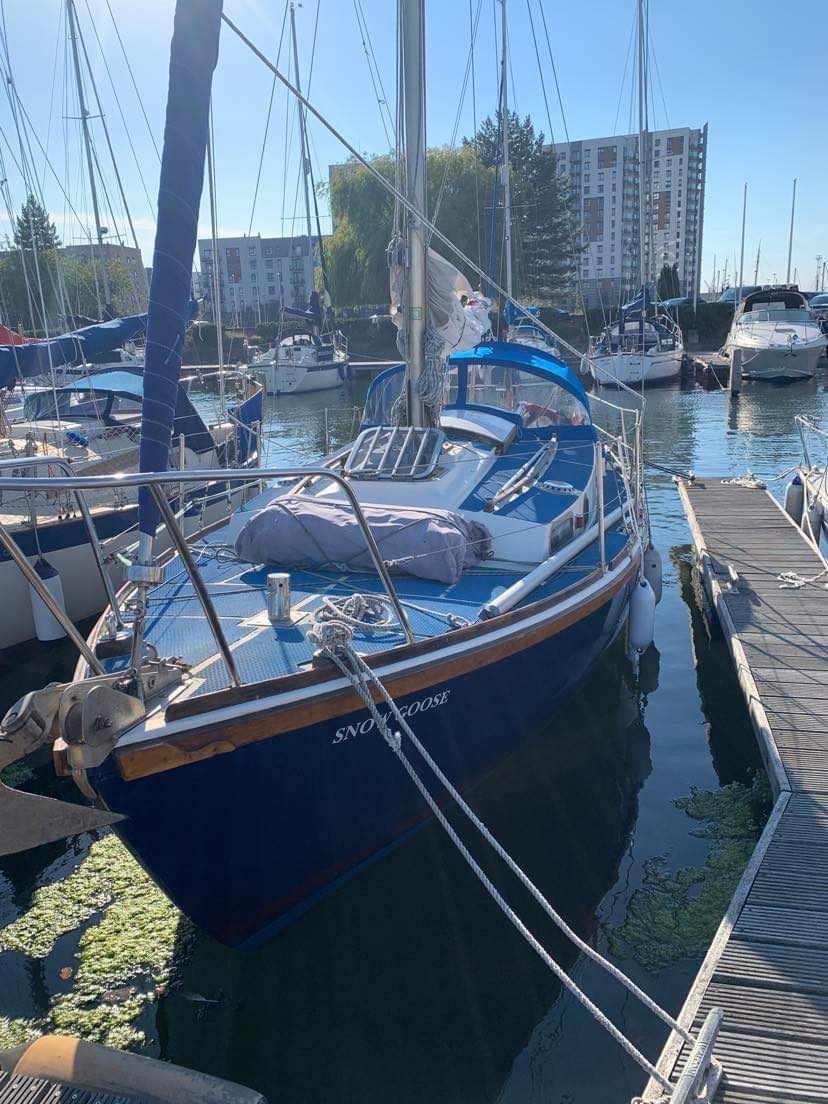
We chose a particularly high spring tide weekend in August to give ourselves our best chance of crossing the sands and the Broomway, the ancient causeway used to get access to the islands before there were roads on land, and through the MOD run lifting bridge itself. Planning the passage is not in itself difficult, the distances are not huge and the options for the course are limited, but timing is everything. The consequences of a serious grounding at high water springs are not attractive so you need to arrive at the Havengore Bridge preferably about an hour before high water and certainly within the last hour of the rising tide, giving some chance of getting off again if you go aground before high water. Given this timing imperative you only get one go at the route and there comes a point on the passage where you have to commit. To get there at the right time from the Medway on this particular weekend we would be punching into the rising spring tide with a brisk north easterly on the nose for much of the route - So much for passage planning with the tides!
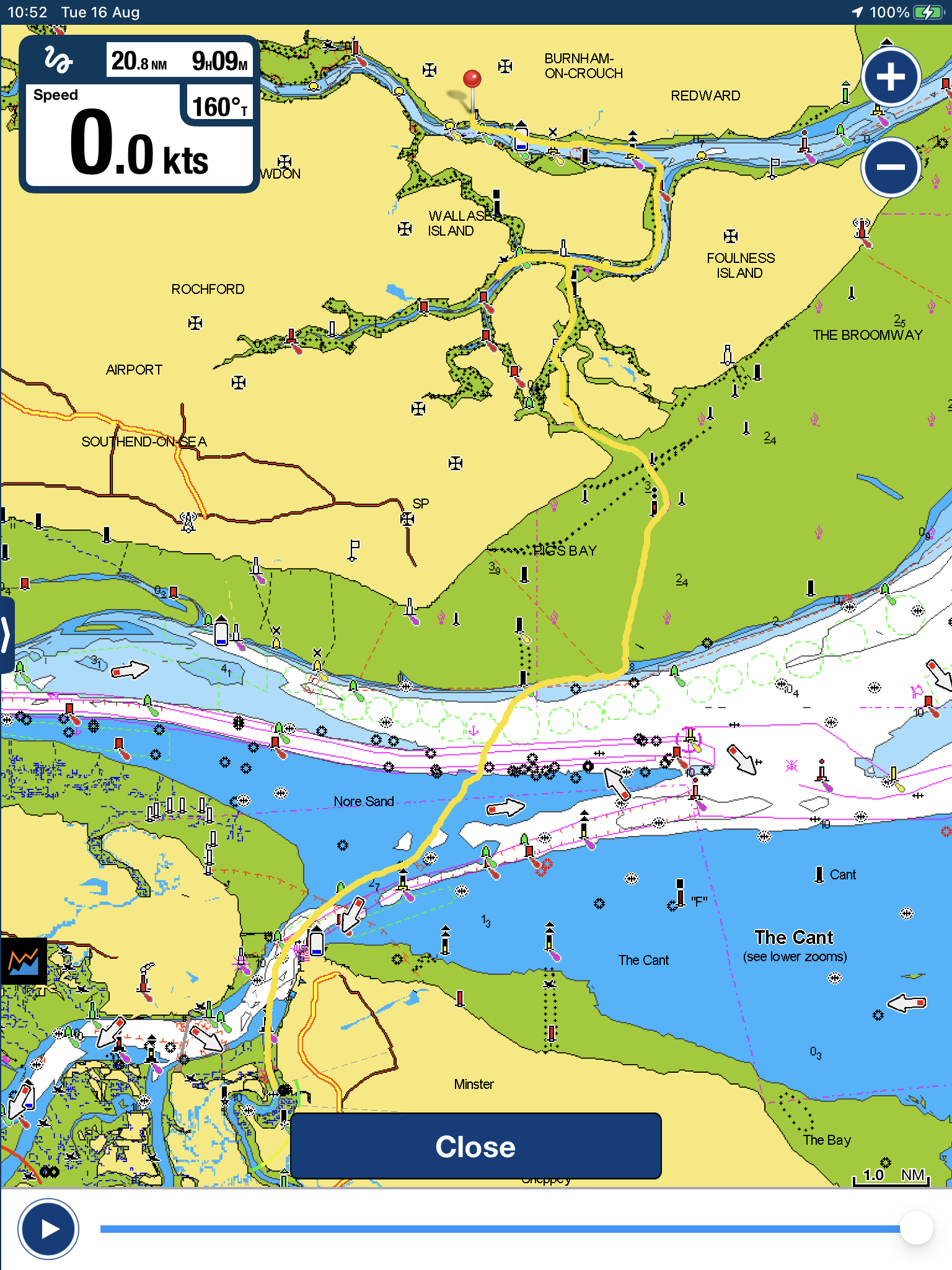
Our starting point was Queenborough and my plan had us setting off at 1000 but the propellor and hull being a bit sluggish from a summer of significant weed growth, we decided to leave early and if needs be wait at the Artificial Island to go across the sands. So an 0830 start had us at the Grain Fort at 0900 and the wreck of the SS Montgomery for filming at 0955. The masts are all that is visible above water and these are to be cut off this year to prevent them falling onto the wreck below and setting off the long anticipated explosion and tsunami. So filming them before they go seemed appropriate and we passed the wreck as close as permitted. I used to be frightened of this submerged leviathan, something spooky about it, but I’ve got used to it now and it is a welcome staging point on my journeys in and out of the Medway. The engine was overheating slightly and we needed to stop and clear the raw water filter, solid with weed, to cure it. Then across the shipping lane, choosing to pass behind the surprisingly fast moving container ships rather than in front.
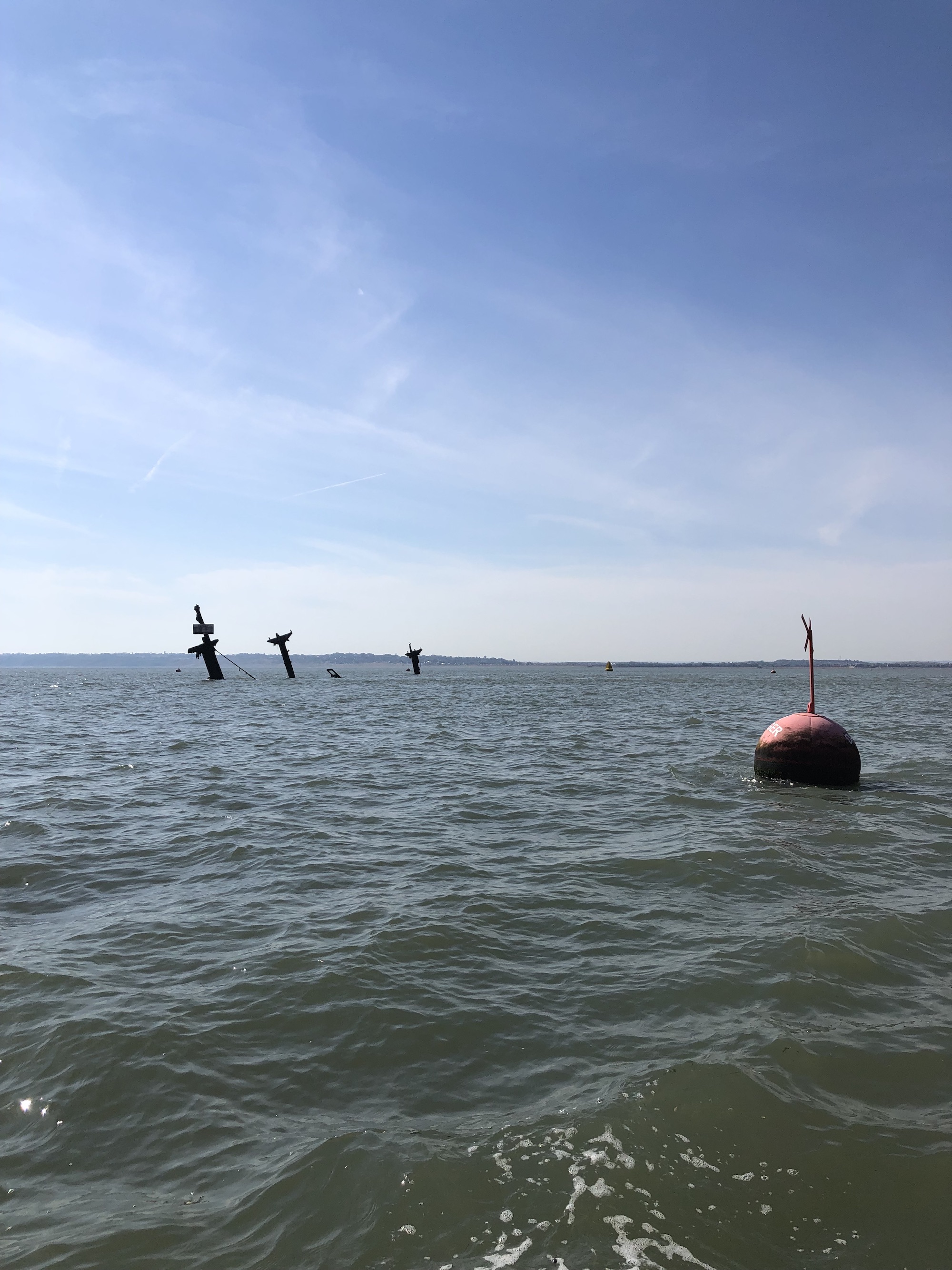
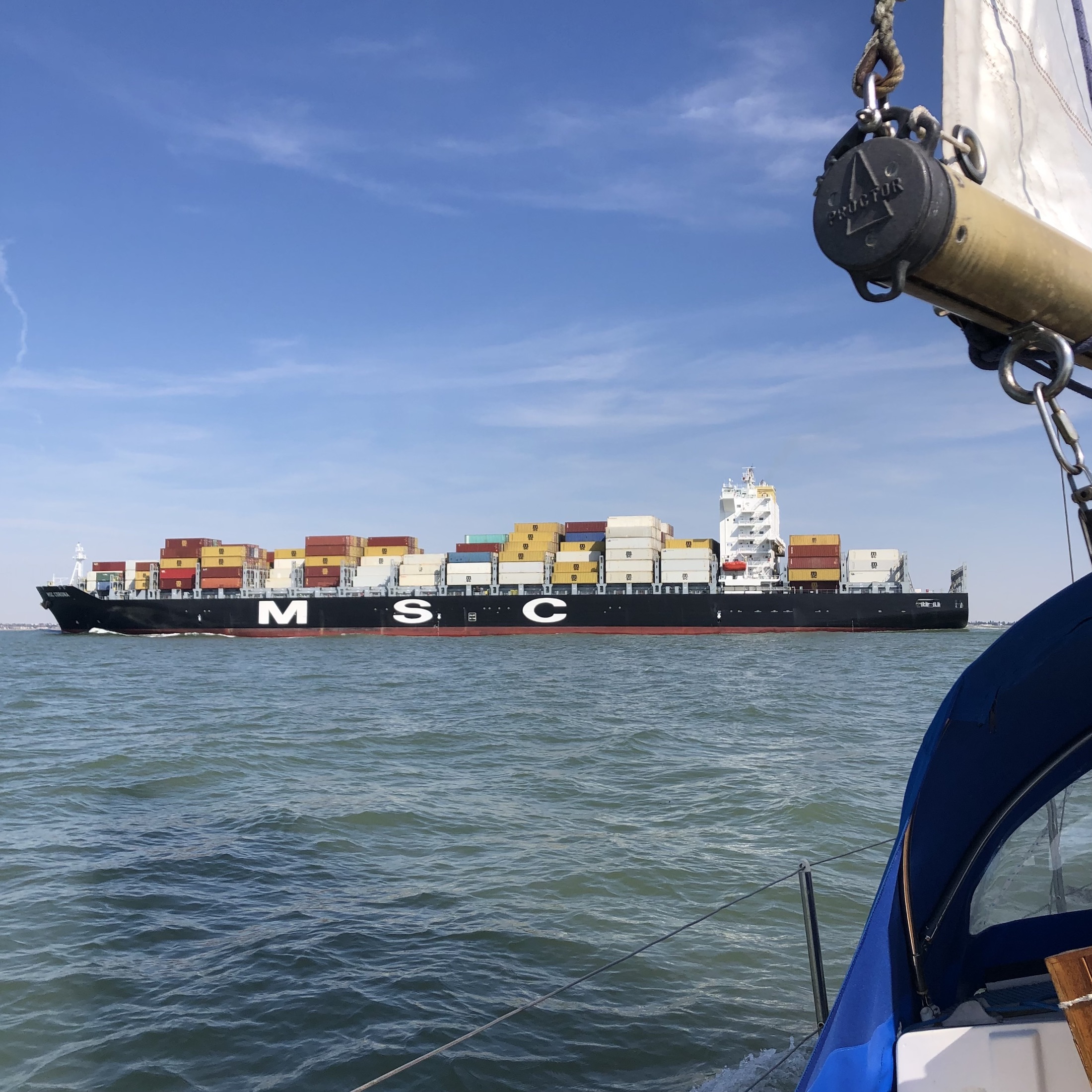
With wind and tide against us it was a slow motor for most of the way, with speed over the ground sometimes as low as 1.6 knots. But eventually we got to the Artificial Island. Only covered at high water springs, this mound is all that is left of the explorations for putting the third London Airport on these sands - What a good thing it did not go ahead. Our early start meant that we arrived an hour ahead of schedule so dropped anchor in the deeper slightly more sheltered channel to the east of the island and had a rather rocky lunch in hot sunshine and beautiful turquoise light. At 1300 we set off across the sands with the Bridge Keeper’s assurance that he would open it when we got there. It takes an hour and ten minutes to the bridge from the Artificial Island so we arrived well ahead of high water at 1500. We had enough water all the way, at it’s shallowest over the Broomway the depth guage showed 1m below the keel – plenty! Navigation here is difficult, it is hard to pick out the guide posts against the complex colours of the shore and it is made more tricky by some of the posts described in my (out of date) copy of the East Coast Pilot not being there any more. Fortunately the important ones, those at the Broomway itself, were still standing and by following the recommended route we were fine. You have to hold your nerve and keep going in towards the North shore before turning sharply west towards the Bridge. But all went well and the bridge keeper waved us through into another world.
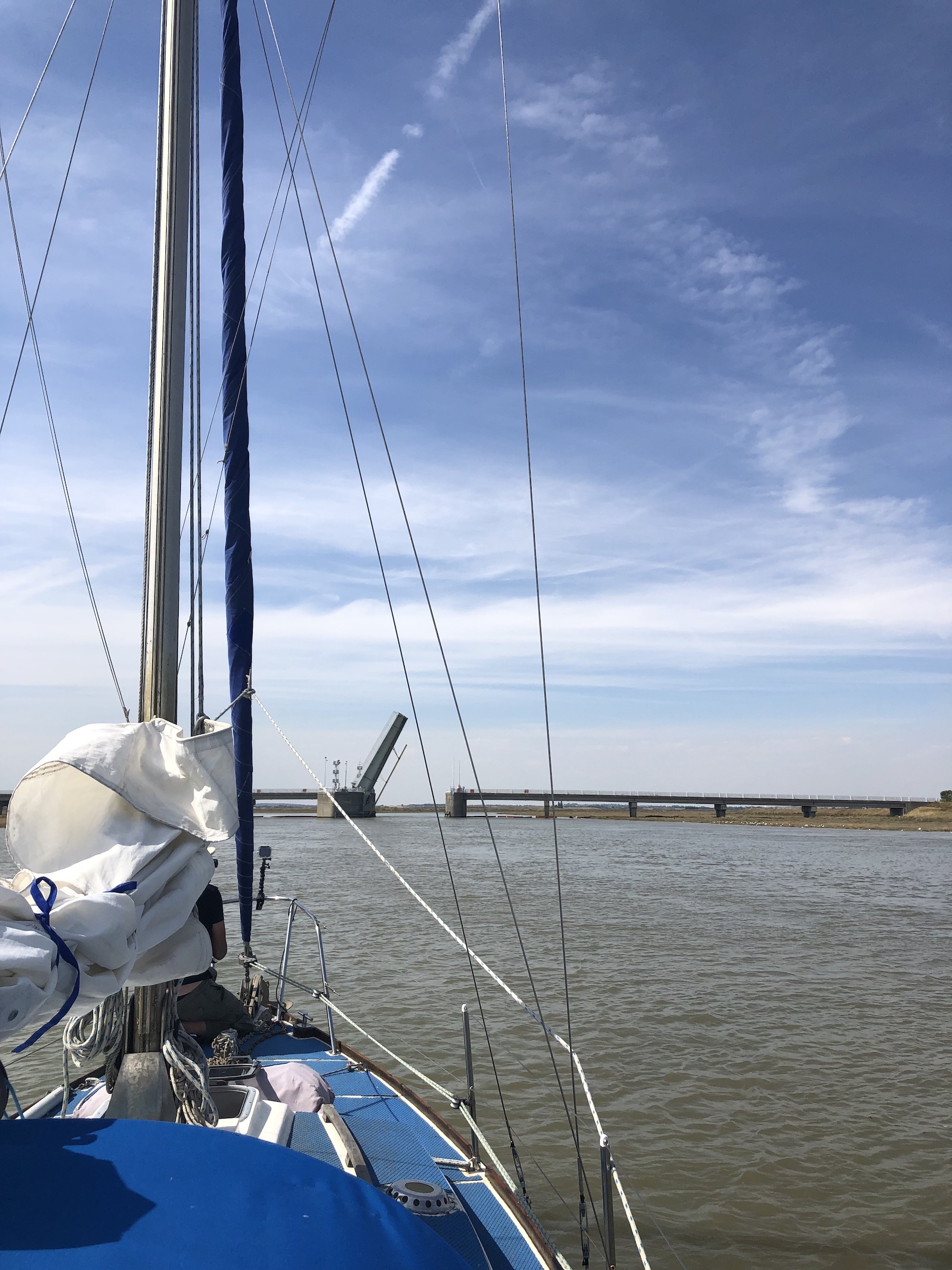
The upper tributaries of the roach are a sharp contrast to the Estuary, suddenly quieter and more relaxed after the stress of sailing over very shallow water. We had a seal for company leading us all the way through the wonderfully named Middle Way and there were birds everywhere. On reaching the Roach itself via Yokesfleet Creek we turned up stream to Paglesham in search of the resting place of the Beagle. This is an unmarked stretch of foreshore, and the ship is invisible, apparently buried under the mud. But it was somehow intriguing to know it is there, perhaps waiting to be uncovered some day.
Being a little too low on Diesel for comfort on the trip back the next day we decided to go on to Burnham rather than anchor in the Roach for the night. This doesn’t seem far but once in the Crouch it was a long motor up river against the strong ebbing spring tide to Burnham Yacht Harbour. We clung to the North shore to get out of the main force of the tide but I noticed a number of boats were making their way up river close to the South shore and regretted not joining them as we crept through the moored boats past Burnham very slowly indeed. But Burnham Yacht Harbour was worth getting to, welcoming and helpful, providing diesel and showers for a hot crew. Burnham town was weirdly quiet for a mid August weekend – where was everyone?
The next day the Havengore Bridge was only going to be open from 1630, too late to be useful to us so it was back across to the Medway the long way round for us - out by the Crouch to the Whitaker and into the Thames Estuary. We decided on an early start to ensure we could get round the Whitaker Spit before low water so set off into the dawn at a bracing 0505. It was very atmospheric whizzing down on the tide in the in the mist through the moored boats at 6 knots plus and watching the dawn as we headed East. I am always surprised at how long this leg takes but the tide was running fast and we made it to the turn in a record (for us) two and a half hours. This was great but it meant that we were going to be sailing into wind and tide for the first hour or so of the next stage. The wind built to a pleasant 10-14 knots so we enjoyed beating back and forth improving our tacking skills all the way to the Swin. This used up our time advantage so we had to give in to the motor to stay on schedule. The plan was to get to Stangate Creek in the Medway by high tide to anchor for the night but we had done so well that as we came into the Medway past Sheerness it was clear we could get all the way to Gillingham by high water at 1600, so we kept going. The engine overheated slightly again in the Medway so we hove to, in water shallow enough to anchor should we need to, and cleaned the filter for the third time in a weekend.
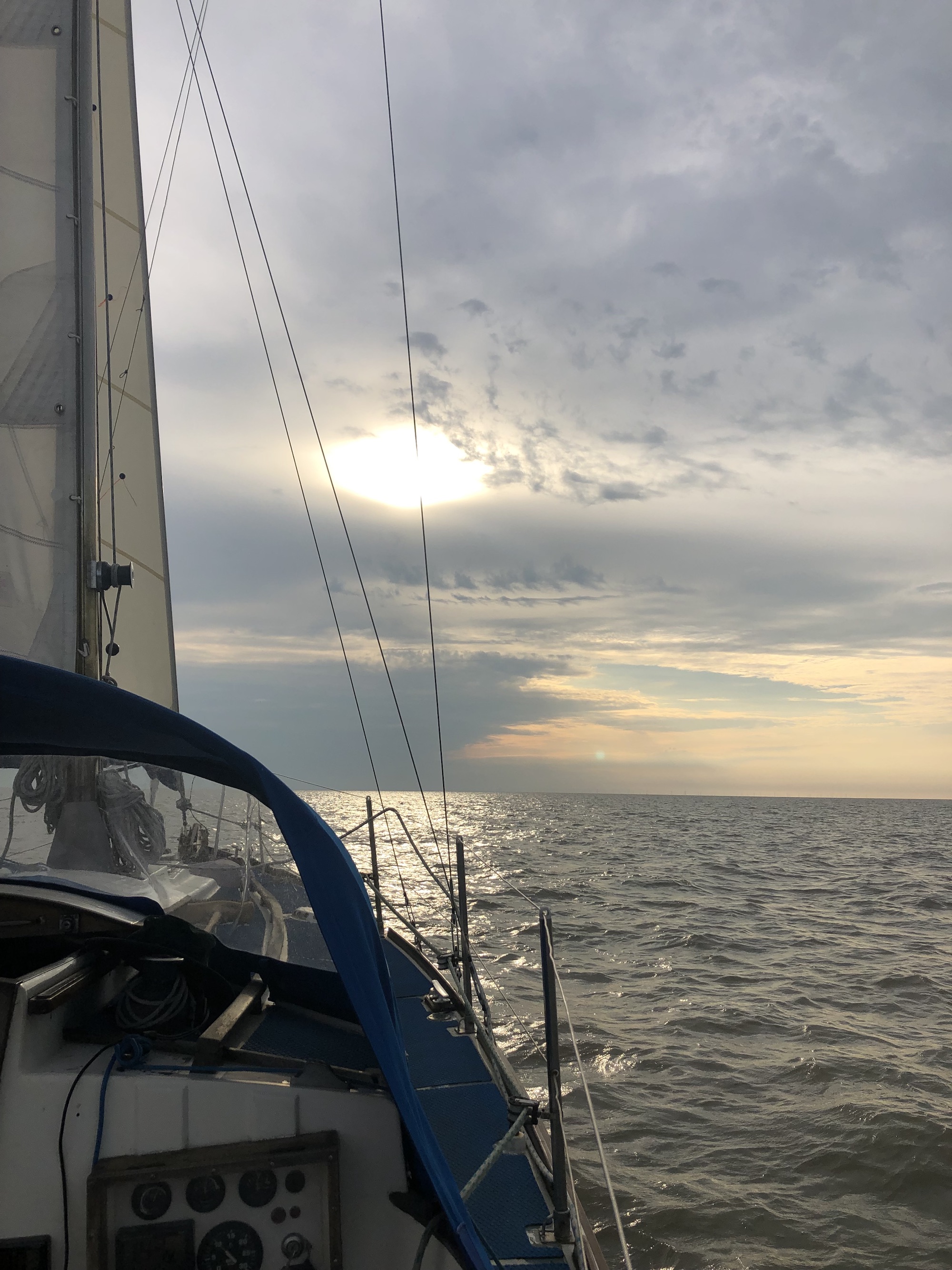
Apart from weed in the strainer the boat performed excellently and this was a memorable trip. The Havengore is a perfectly viable route to Burnham from the Thames and well worth the planning to ensure it goes smoothly. Filming on a small boat comes with its challenges, limited space to move around in and sudden lurches from a ships wash don’t help. But as I learned from my expert and well equipped companion there are ways round this and a ‘gimble’ to stabilize the camera smooths out sudden movements. Hopefully we produced some good footage. We certainly had good light.
For Pablo Behrens see: THE CROSSING https://vimeo.com/535981537/c096cbdb9a Instagram: @londonslastwilderness
